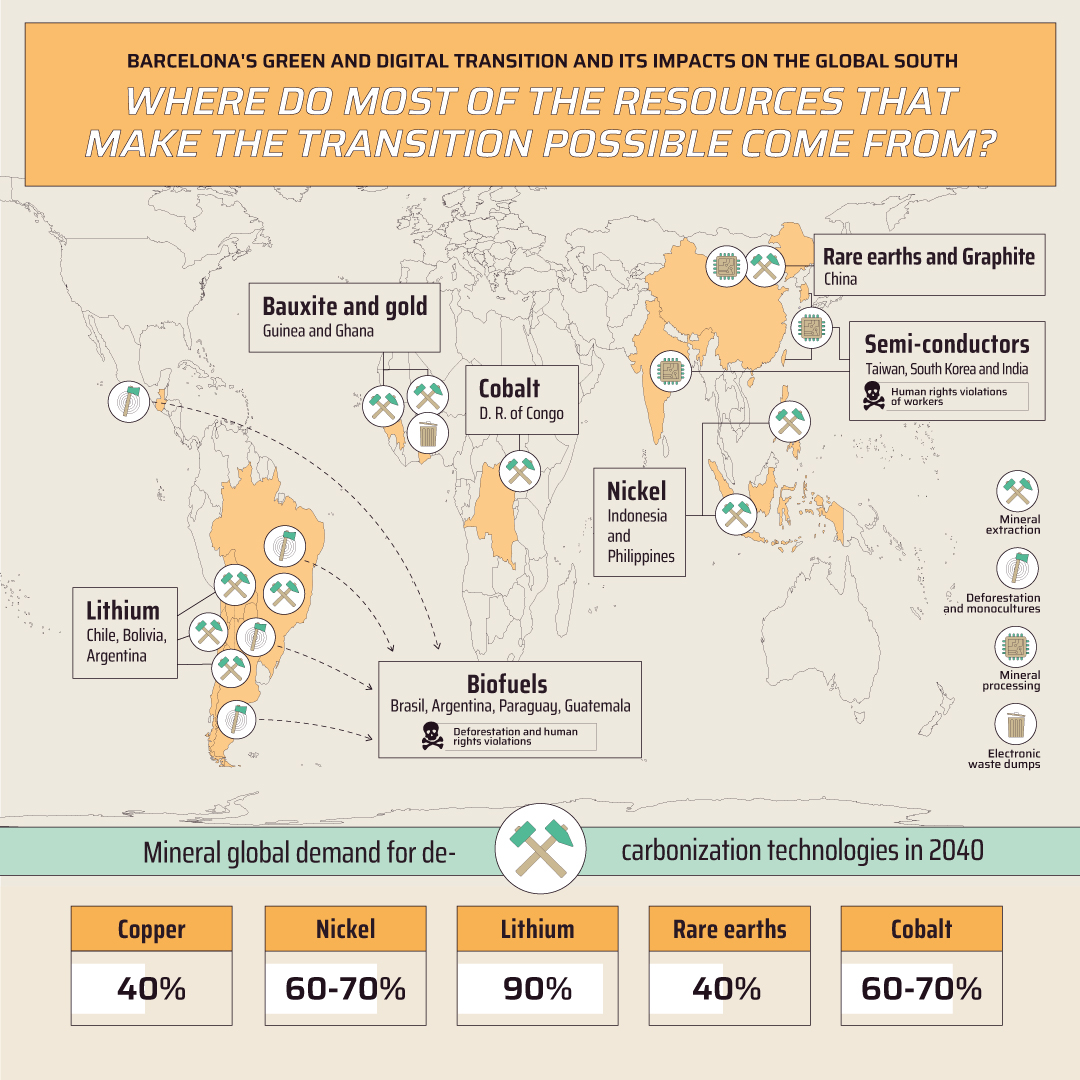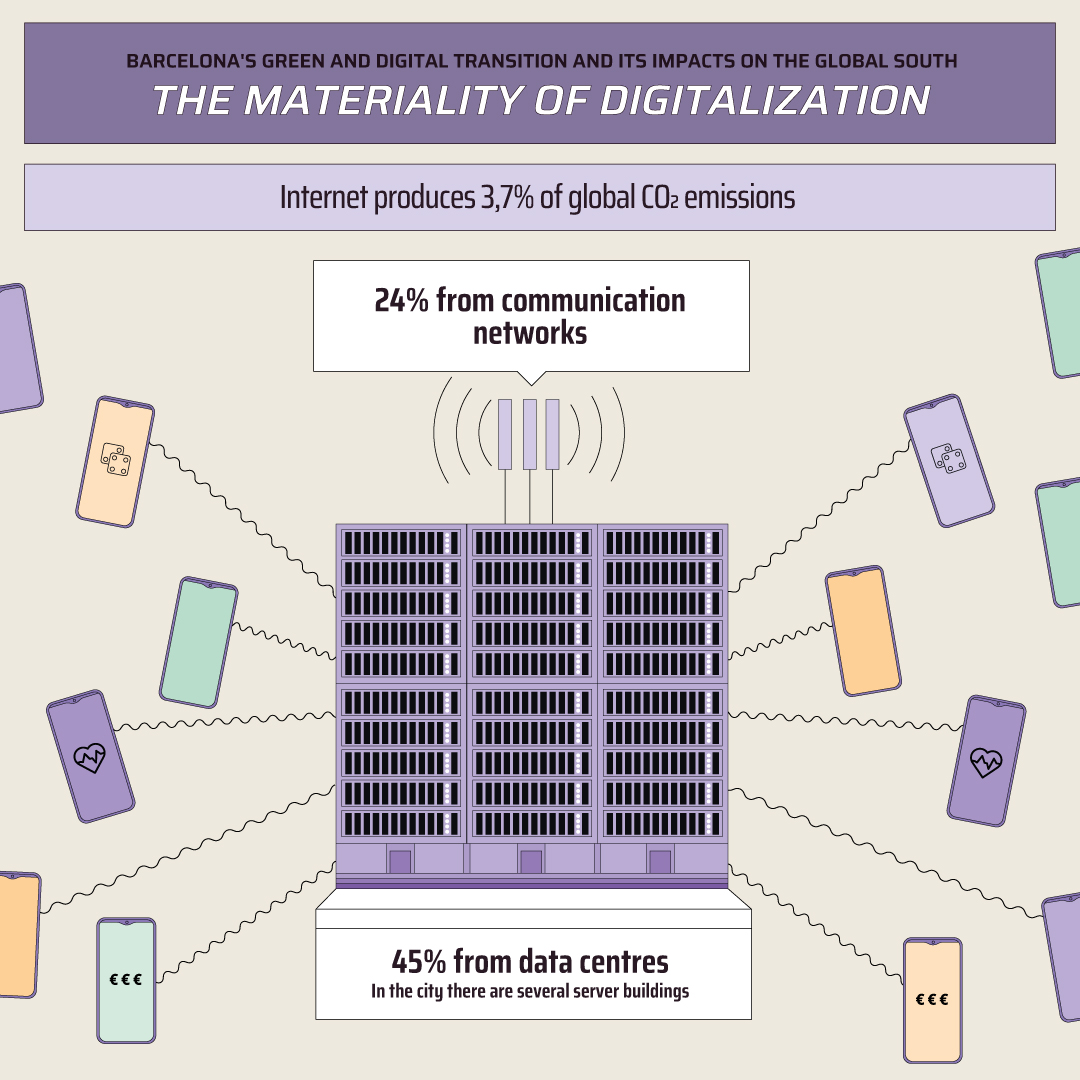Which are the material implications of the pursuit of electro-mobility, digitalization and expansion of renewables without questioning the growth model?
This map is the result of a collaborative effort bringing together activists, NGO staff and academic researchers to create a «map illustration» of the impacts that Barcelona’s green and digital transition will have in territories of the Global South.
The EU has presented a twin transition – green and digital – to be led by big corporations. A transition, hence, based on the economic growth model, that does not contemplate planetary boundaries and social justice. The transition requires large amounts of raw materials to produce renewable energy technologies and digitalisation. Consequently, the interest for the business of the green transition has soared, to capture the supply chain of «green» technologies, and a global race for critical raw materials has begun.
The case for this illustration is the city of Barcelona. The City Council’s proposals for a transition away from fossil fuels and for digitalisation will also require raw materials. For example, the implementation of policies to promote electric vehicles (such as the Low Emission Zone) require a large amount of lithium and other minerals to manufacture the batteries. This rapid increase in demand of raw materials will have severe impacts on the commodity frontiers.
The material basis of the transition
The minerals needed for this transition are unevenly distributed around the world. Many of the resource rich territories are in the Global South, and they have become the focus of governments and companies to ensure the flow of critical materials for the transition. As shown in the map, the extraction of raw materials in countries of the Global South is generating numerous socio-environmental conflicts. The increase in demand associated with decarbonisation technologies – wind turbines, solar panels, electric vehicles, etc. – represents 40% of global demand for copper, 40% for rare earths, 60-70% for nickel, 60-70% for cobalt and 90% for lithium by 2040. These minerals are also needed for digital technologies such as mobile phones or Bluetooth devices.
On the other hand, China controls part of the market for both green and digital technologies. Thus, many of the manufactured products that arrive to Europe, and therefore to Barcelona, come from China: 30% of electrolysers, 60% of wind turbines, 60% of solar panels and 40% of electric cars.

Energy model
The capture of renewable energy has a material basis: in order to manufacture renewable technologies, many of the minerals that the EU has described as critical and/or strategic are needed. Currently, only 7% of the total energy consumed in Barcelona comes from renewable sources. Therefore, switching from fossil fuels to renewables will have impacts, as it will require the extraction of minerals to manufacture wind turbines, photovoltaic panels, batteries for storing the electricity generated, etc.
On the other hand, infrastructures such as the port have a significant energy consumption in the city. Instead of planning to reduce the number of cruise ships and minimise the energy consumption of the infrastructures linked to the port, the City Council is proposing to electrify the port. If the electricity is to come from renewable sources, this implies an increase in the city’s demand for renewable energy.

To move around the city
The map highlights the impact of the mobility transition on total mineral demand. The replacement of combustion vehicles by electric vehicles is the main driver of the increase in demand for critical materials, accounting for 50-60% of the total. In particular, they mainly require lithium, cobalt, rare earths, graphite, nickel, copper, manganese and aluminium. Mineral demand for the production of electric vehicles is expected to increase 40-fold by 2040.
In Barcelona, the total vehicle fleet was 811,673 in 2021, while the number of electric and hybrid vehicles as a percentage of the total is 5%. Policies such as the Low Emission Zone or the Plan Renove promote the purchase of new hybrid and electric vehicles to replace existing vehicles. If all existing private vehicles were to be replaced, this would imply an exponential increase in the demand for minerals to manufacture them.
On the other hand, hydrogen vehicles are alos seen as part of the solution. For example, TMB 2025 Strategic Plan foresees 46 hydrogen buses by 2025, with a commitment to green hydrogen. Promoting green hydrogen makes it possible to externalise the impacts of the necessary expansion of renewables for its production in other territories. In other words, it would allow for hydrogen produced with wind energyin Morocco or Alt Camp to be transported to and combusted in cars in Barcelona. In fact, in Barcelona there is the only hydrogen plant (hydrogen refuelling station) for public use in Spain, owned by Iberdrola, with 2.5 MW and financed with European funds of €3.8 million.
When it comes to other means of transport, aviation is the most polluting one. That is why the industry says it will replace kerosene (the fossil fuel used by aircraft) with biofuels and hydrogen. Currently, biofuels account for less than 0.01% of all aviation fuel, and increasing production requires more monocultures. In fact, today, biofuels consumed in Europe cover an area of 9.6 million hectares – more than the entire island of Ireland.
Hydrogen, on the other hand, will not be viable for medium and long-haul flights before 2050. Until then, only the regional and short-haul market, much of which can be replaced by road or rail, could be converted. But before hydrogen airplanes become a reality, many technical problems must be solved. Deploying “green” hydrogen in aviation would require large amounts of renewable electricity, depriving other sectors of the need to decarbonise.

The hidden cost of digitalization: it is material
All the digital technologies needed for the digitalisation of life also have a material basis: they need minerals to be manufactured. The city hosts the annual Mobile World Congress (MWC), a trade fair that aims to develop the 5G network. Internet generates 3.7% of global CO2 emissions and has a 4% annual growth in energy intensity. 45% of consumption is in data centres and 24% in communication networks.
In addition, the MWC also encourages the consumption of new mobile phones. If every person over the age of 15 has a smartphone, there would be 1,461,547 smartphones in use in Barcelona (apart from the old ones that everyone has in their drawer). Promoting events like the MWC means encouraging the purchase of new technologies and increasing the pressure on mineral demand.
On the other hand, there are several server buildings in Barcelona. These machines have a huge energy consumption for cooling, as they need to maintain the right temperature for all computer systems in full operation 24 hours a day, 7 days a week. Digitalisation therefore has material implications.
The end of life cycle
Electrical and electronic equipment remains one of the fastest growing waste streams in the EU, with an annual growth rate of 2%. Moreover, this waste contains toxics, and the collection rate is still low: less than 40% of e-waste is recycled in the EU.
During 2019, 53.6 million tonnes of e-waste were generated worldwide, of which only 17.40% was properly recycled. In Barcelona, around 500 tonnes of e-waste is collected annually. There is uncertainty about a significant amount of e-waste that ends up in illegal traffic sent to countries such as Ghana, where there are no resources for proper recycling. Agbogblishe, one of the largest electronic waste dumps in the world, is located in Accra. Without adequate protection and means to ensure proper recycling, workers are exposed to toxic waste that often results in very serious damage to their health.
Which are the alternatives?
In this context, there is an urgent need to rethink the economic model. To address the climate crisis with global justice, it is necessary to advance the decarbonisation of the economy while drastically reducing the demand for minerals. An economic model based on infinite growth is incompatible with this imperative. It is therefore necessary to propose scenarios of economic degrowth in the global North in general, and in Barcelona in particular, in order to reach the sufficiency that guarantees dignified lives for all and the continuity of life on the planet.
Urban mining can help to move in this direction. It involves the recovery of minerals already extracted from e-waste and other waste present in the city. It is a hitherto little explored but promising avenue. While it is not a substitute for the increasing demand for raw materials, urban mining can contribute to their supply with less climate and social impact.
Furthermore, rethinking the mobility transition is paramount: to reduce mineral demand, it is necessary to move away from the individual car paradigm. It is also necessary to promote walking and cycling while enhancing collective and public transport.
More information: See Reference list
